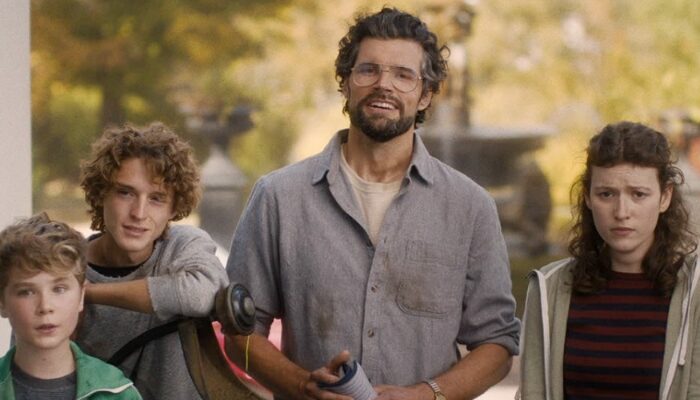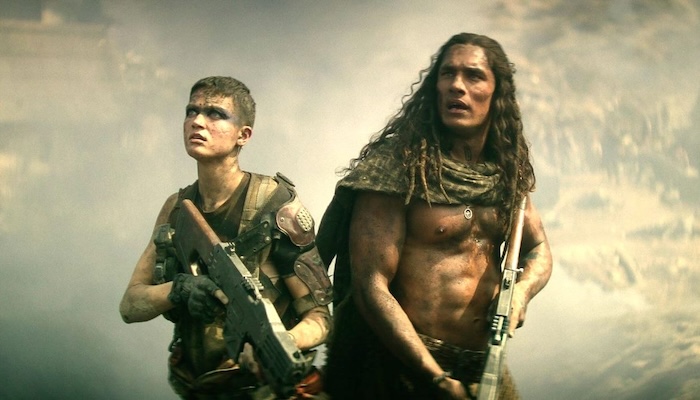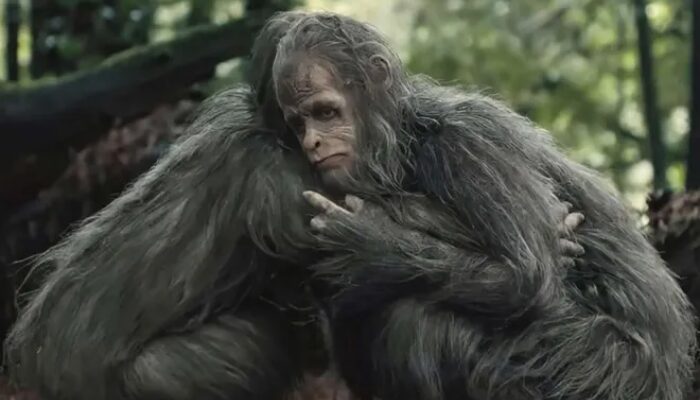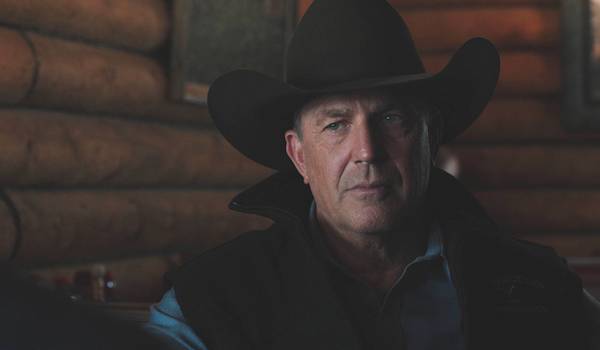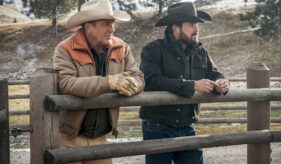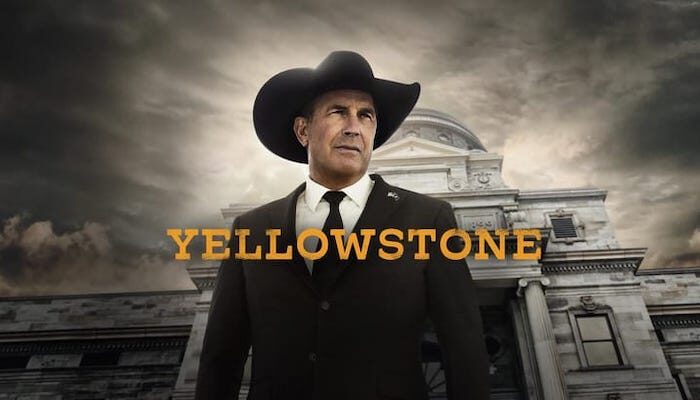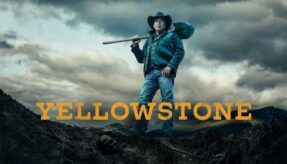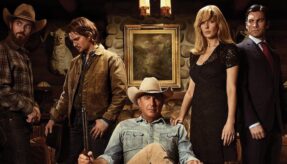TV Review: YELLOWSTONE: Season 2, Episode 1: A Thundering [Paramount Network]
Table of Contents
Yellowstone A Thundering Review
Paramount Network‘s Yellowstone: Season 2, Episode 1: A Thundering unceremonious ends the darkest segment of Yellowstone – John Dutton (Kevin Costner) slowly dying of colon cancer. With Yellowstone turning into a bonafide television hit, something had to give and it is the John Dutton dying storyline. This was a mistake. The John Dutton dying storyline should have remained intact, not matter the ratings or number of seasons ordered. John Dutton dying was part of the Yellowstone‘s black, rich tone. The show should have remained in that darkness with a clocking ticking on the patriarch of the Dutton family. Yellowstone would have survived, like Game of Thrones survived the death of its main character in Season One, if the other characters in Yellowstone were fully rounded out and given three-dimensionality. Beth Dutton (Kelly Reilly) certainly could have carried part of Yellowstone‘s narrative load following John Dutton’s death. The way she has been written and acted is brilliant. Her personality is almost terrifying in its ferocity. If the other characters, like Jamie Dutton (Wes Bentley), were written as robustly and given strong personalities and personal motivations, it would have been possible.
The Cancer Fix
What type of medical doctor misdiagnoses a specific, tested for, and deadly type of colon cancer for an ulcer that can easy be operated on? John Dutton would have sought a second opinion on the colon cancer diagnosis once he received it. The original doctor who diagnosed John’s colon cancer would have asked for a consult to be sure of what he was seeing. None of these people, none of these tests (including x-rays), saw the ulcer and all of them saw colon cancer? That is highly and extremely dubious, stretching taught believability.
It’s a horse veterinarian who, via a single chest and pelvis X-ray, no followup tests, no sample-taking, sees something that none of the doctors that work on human beings for a living saw? She looks at the x-ray for six seconds and sees exactly what it is and what it isn’t? Really?
Writer Taylor Sheridan wanted to figure out a way to keep John Dutton alive and on the show and this is how he does it?
For such a gifted writer, this major plot point pivot is weak. As a fan, I can and will accept it (even though it is detrimental to the show), but keeping John alive could have been done in a far more believable way. Examples: John goes for chemotherapy and it works. Or John goes into surgery again, it’s successfully, and they are able to fully remove all the cancer cells. Or the inexplicable – a new cancer treatment comes out and John, through his vast wealth and connections, is able to get in on the first clinical trial for that drug. An miracle happens and his cancer goes into remission because of that drug.
None of these simple answers are utilized. Sheridan, instead, uses a rickety Veterinarian trap-door as his device to change John’s fate. As I said, I can live with it but I wish I didn’t have to.
Taylor Sheridan obviously didn’t know or not if Yellowstone would be renewed for Season Two, let alone Season Three, when he wrote Season One. That imbued him with a freedom that other TV screenwriters never experience. Other TV screenwriters write thinking and hoping for an additional season. The longevity of the TV series is always on a TV writer’s mind. Sheridan didn’t have that constant concern. He wrote the best screenplays possible without any stop-gap in place for where he could or couldn’t go with his characters (e.g. the freedom George R.R. Martin found when he began writing A Song of Ice and Fire). Sheridan basically wrote a great novel with no barriers by his book publisher. Season One of Yellowstone was Sheridan putting his best narrative-foot forward without any other concerns. That allowed him to create a single-serving story that was bleak, tragic, filled with flawed characters, great dialogue (“This is America. We don’t share land.”), dominated by a ticking clock (a wonderful screenplay trope), and bomb that would eventually go off.
Then Yellowstone was renewed for Season Two.
Then the course-correction happened while Season Two was being written – the ticking clock was silenced and the bomb was disarmed. Encroaching death, which had begun to define more and more of John Dutton and his actions in Season One, was eliminated. That gigantic motivating factor, the part that made John reflect on a lifetime of decisions, that had softened him to certain people (e.g. Rip Wheeler), and made him see his family, and legacy in a new way, was eradicated.
From a TV producer’s perspective, I understand why this was done. They want to keep Yellowstone going as long as possible and Kevin Costner a part of the show as long as possible. From a writer’s perspective, Taylor Sheridan made absolutely the worst choice possible for his magnificently written and realized character. If I had been fortunate enough to create a character like John Dutton, ripping out his increasingly important and defining characteristic would be unthinkable to me, so much so that I wouldn’t do it. I would fight that change, internally and externally, like a deranged ocelot and resign before making such a alteration. Ask yourself a question: how different would Game of Thrones be if Lord Eddard “Ned” Stark had lived past Season One? That reality is now what Yellowstone fans are living in.
Dan Jenkins is Alive
The aforementioned ‘narrative adjustment’ may explain why Dan Jenkins (Danny Huston) is still alive. At the end of Season One, Jenkins was clearly being hanged and would remain hanging until his death. In Season Two, it seems that Kayce Dutton (Luke Grimes) had a spontaneous off-screen change of heart.
The first problem with this is that if they let Jenkins go and he went to the police, he had Kayce, Rip, and the rest of the people present before and after the hanging on kidnapping, assault, and attempted murder. Jenkins’ DNA was all over the Yellowstone truck seat they through him on, hair and DNA from the Yellowstone ranch may have been on the rope used to hang Jenkins, and Jenkins would have rope marks on his neck to show to the police. Jenkins could have filed charges, had arrested, put in jail (they would have all been bonded out), and put on trial almost all of John Dutton’s key Yellowstone personnel, not to mention his son. There would be a state prosecution, Jenkins would be painted the victim, he would sue the ranch in civil court, and the press would have a field day.
Why would Kayce risk any of that by letting Jenkins go? It defies reason.
The second problem is that Jenkins admitted that he tried to kill John Dutton with a traffic accident that ended up killing Dutton’s truck driver. Attempted murder of his father, the murder of someone Kayce may have known, and this former U.S. Navy S.E.A.L. lets Jenkins go? Why?
At the end of Season One, it was beneficial to Yellowstone‘s narrative that: a.) Kayce went Midnight Train-dark in his last scene in The Unravelling: Part 2, b.) he set an unforgiving tone with the branded, c.) Kayce’s reign began with something that his father would have done, and d.) a main character was killed off in the final act of the episode.
A Thundering undid all of that dramatic splendor in one semi-tense dinner scene.
Yellowstone doesn’t need Dan Jenkins. Jenkins is a fulcrum that causes reactions in Yellowstone‘s main characters, nothing more. Though Danny Huston’s acting would have been missed, a new catalyst could easily have been moved into his character’s place.
The only reason Jenkins is still alive is because of the Season Two and Season Three realignment (like John Dutton’s cancer disappearing in the space of one episode). That is the only rational explanation one can think of for Jenkins still drawing breath on Yellowstone after everything he did and admitted to. Yellowstone‘s producers wanted to keep a good actor on the show that is already contracted and build up that actor’s villainous character.
Though the rationale for Jenkins being alive is understandable, from a TV producer’s perspective, as a reality-based TV series, Yellowstone would be more authentic if Jenkins was dead.
Since Jenkins is still alive, did Beth ever buy enough shares in Jenkins’ company to put herself on its board of directors like she was going to do last season?
Beth and the Ranch Wall
Beth Dutton is equal parts pro-active action (e.g. buying land to protect Yellowstone) and reaction (e.g. hiring a comely election opponent for Jamie Dutton to contend with) in A Thundering. What is missing is the aggressive agency she showed in Season One of Yellowstone, spitting in everyone’s eye, and leaving wreckage in her wake. Season Two Beth has reined herself in, is focused, and has found a reason to be sober – defending the Yellowstone ranch against all of its enemies.
Beth has a gigantic well of will-power to delve into whenever she chooses to do so, a reservoir created by her mother, father, and a childhood spent on the Yellowstone Ranch. In A Thundering, the results of such a dive are on display and a stable Beth is presented to the viewer for the first time.
Will her newfound sobriety and big-picture thinking eventually lead her into politics like her father previously desired? If that completes the wall around Yellowstone that she is erecting, Beth will do what is necessary.
Enter Cowboy
New ranch hand Cowboy (Steven Williams) is a good addition to the cast, bringing nostalgia and the ancestry of the cowboy way of doing things with him. Cowboy is brazen in the way that he speaks, not caring if he offends because of the truths inherent in his words. He is a powerful influence on all the younger ranch-hands as they can tell that he has been there and seen it all. Though they don’t seem to consciously know it, the younger ranch-hands want to earn Cowboy’s respect.
The Bar scene and Walker
Kayce and Rip Wheeler (Cole Hauser) rectifying the result of the bar fight is one of the most entertaining and brutal segments of A Thundering. This moment showed the breath of Yellowstone Ranch’s reach and its influence at a ground level in Montana. Rip and Kayce aren’t just acting as avenging angels when they bring the bull to the bar. They are upholding the untouchable mystique of Yellowstone and its employees. Rip has been the caretaker of both since he became third-in-command at the ranch, second after Lee Dutton was killed. Kayce passed no bucks during the retribution operation but it was Rip’s show.
That same ringmaster is quickly spoiling on Walker (Ryan Bingham) and his lack of commitment to the brand. Walker isn’t malleable like Jimmy Hurdstrom (Jefferson White), he won’t bend or break to Rip’s will. That means Rip and Walker are quickly reaching a breaking point – something or someone will have to give. I doubt it will be Rip. His behavior, personality, and expectations of the branded are hardwired.
Leave your thoughts on this Yellowstone A Thundering review and this episode of Yellowstone below in the comments section. Readers seeking more Yellowstone can visit our Yellowstone Page and our Yellowstone Facebook Page. Readers seeking more TV show reviews can visit our TV Show Review Page, our TV Show Review Twitter Page, and our TV Show Review Facebook Page. Want up-to-the-minute notification? FilmBook staff members publish articles by Email, Twitter, Facebook, and Tumblr.
Related Articles
FilmBook's Newsletter
Subscribe to FilmBook’s Daily Newsletter for the latest news!

